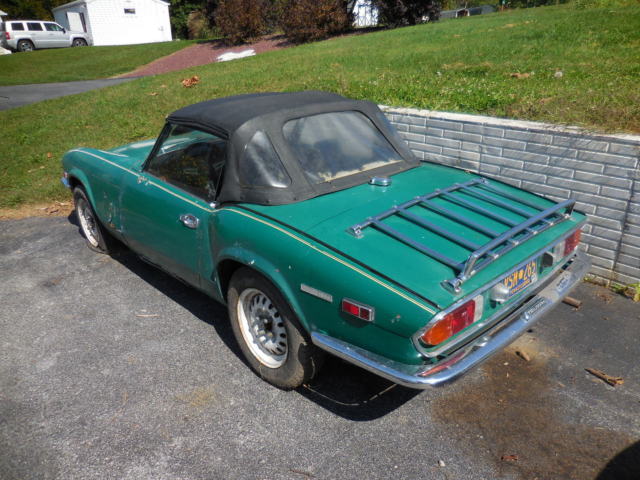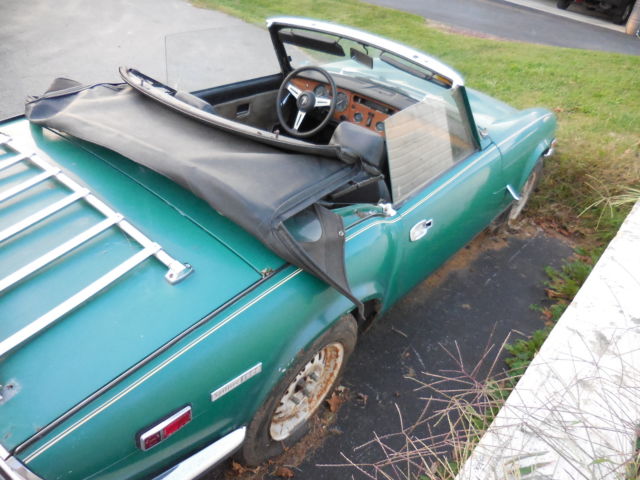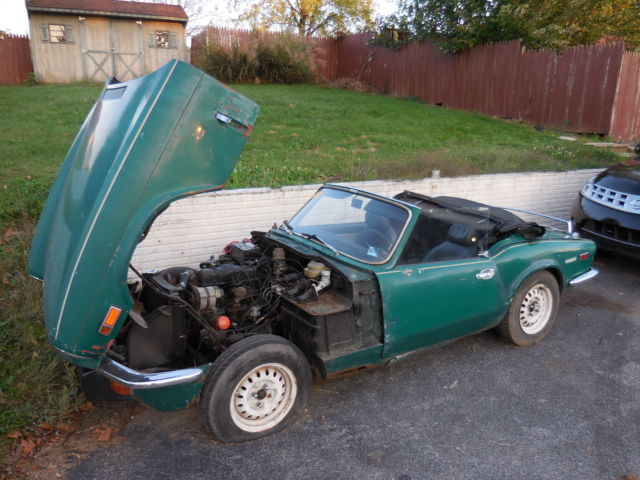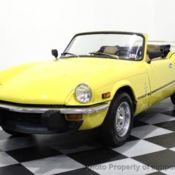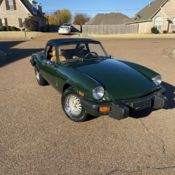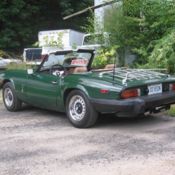COOL CHROME 1973 TRIUMPH ,ENGLAND SPITFIRE 83,386mi GREEN CONVERTIBLE ,CAR
Technical specifications of Triumph Spitfire 1973
| Price: | - |
|---|---|
| Item location: | Fayetteville, Pennsylvania, United States |
| Make: | Triumph |
| Model: | Spitfire |
| Type: | Convertible |
| Trim: | chrome |
| Year: | 1973 |
| Mileage: | 83,386 |
| Color: | british green |
| Number of cylinders: | 4 |
| Fuel: | Gasoline |
| Transmission: | Manual |
| Drive type: | RWD |
| Interior color: | Black |
| Drive side: | Left-hand drive |
| Vehicle Title: | Clear |
| You are interested? | Contact the seller! |
Description
UP FOR AUCTION A 1973 TRIUMPH SPITFIRE ROADSTER. 83,386 ORIGINAL MILES. STARTS, THEN STALLS (CARB LEAKING FLUID) LAST DRIVEN IN 1991. NO TITLE. THIS WAS A PROJECT CAR I RAN OUT OF TIME FOR. IT COMES WITH 4 BRAND NEW ARCHILLES SPORT TIRES . IT WOULDNT TAKE MUCH TO GET THIS BACK ON THE ROAD AGIAN. THE TOP IS IN VERY GOOD CONDITION. IT HAS A SMALL TEAR, BUT OVERALL IN WORKING ORDER. IT WAS LEFT AT A SHOP IN 1991 AND THEN ABANDONED. THE LAST PICTURE SHOWS THE LAST OWNER FROM REGISTRATION . IN THE STATE OF PA TO GET THE TITLE IN YOUR NAME YOU PETITION THE COURTS, THEN RUN AN AD IN LOCAL PAPER (WYOMISSING) 2 WEEKS . THEN HAVE TITLE TRANSFER .
OWNER REVIEW 1973 Spitfire 1500 — Handling is fantastic, braking is also fantastic. The car only weighs 1700lbs so its performance handling wise is quite good. However power is lacking it maxes out at around 65ish (maybe) horsepower. Interior is good. Black leather seats, wood dash, Smith's gauges; it has it all. It has been said that "when you drive a spitfire, you remember how much fun driving is" nuff said.
Primary Use: Sport/fun (spirited driving, track racing, off-roading, etc.)
Pros: Unique, sporty handling, good exhause note.
Cons: POWER
HISTORY OF TRIUMPH SPITFIRE
In 1962 the British company Triumph introduced a two-seater sports car named the Spitfire. The Austin-Healey Sprite had proven there was a demand for small cars with sporty intentions. Triumph wanted a piece of this market and felt they could produce a better automobile than the Sprite.
In September of 1960 construction of a prototype began and was codenamed 'Bomb'. Triumph used the mechanical components from their small saloon, named the Herald, and transplanted them into the Spitfire. Basically, a sports body was applied to the chassis of the Herald. The Italian designer Giovanni Mechelotti had been instrumental in the creation of the Herald and was tasked with aiding in the creation of the Spitfire. Within a short amount of time, the Spitfire prototype with a standard Herald 948cc engine had been completed. Its body had similar lines to the Triumph's of the past. The front end was a single-piece which tilted forward and provided access to the engine bay. The Spitfire was ready to go into production but unfortunately, Triumph could not produce the vehicle. Sales had been slow during 1960 and by the end of the year Triumph was in financial crisis. Luckily, Leyland Motors was looking to expand in the car market and found their opportunity with Standard-Triumph. Leyland Motors had built a successful business manufacturing trucks and buses. By April of 1961, a deal was in place, funds were available, and Triumph could again resume automobile production.
By removing the Heralds side members, outer rails, and rear outriggers and replacing them with sills, the seats were able to be placed on the side of the chassis, allowing the frame to be lowered a few inches. The frame was shortened by nearly nine inches and the welded body was attached to the frame with twelve bolts. The rack-and-pinion steering and four-cylinder engine were straight out of the Herald; as was the suspension, consisting of a single transverse-leaf swing-axle arrangement in the rear and a front coil-and-wishbone configuration.
In many respects it was a better car than its competition. Triumph designed the car to be small and sporty but not at the sacrifice of comfort or convenience. The easy access to the engine with ample room to make repairs was something no other small car manufacturer was offering at the time. Due to the placement of the engine, there was ample room in the cockpit for the passengers. Luggage space behind the seats and in the trunk was sufficient. Basic items such as rubber mats and a large plastic steering wheel held keep the Spitfire inexpensive.
Before going into production, the name Spitfire was agreed upon derived from a fighter aircraft used during World War II. During its lifespan, lasting from 1962 through 1980, there were five versions of the Spitfire, the MK1, MK2, MK3, MKIV and the 1500. The first version, known as the Spitfire MK1 or Spitfire4, was produced from 1962 through 1964. The name Spitfire4, referencing its four-cylinder engine, is not to be confused with the Spitfire MKIV version, produced from 1971 through 1974. Unlike it predecessors, the MKIV was not labeled 'MK4'. This was to help alleviate confusion.
When introduced it was almost 10% more expensive than the Austin-Healey and continue to be more expensive through most of its production lifespan. In comparison to its competition, it was a better equipped sports car. Top speed was achieved at just over 90 mph and zero-to-sixty was accomplished in about 17 seconds, which, in the 1960's, was good. Heaters, wire wheels, overdrive, and a hardtop were offered as optional equipment. In its introductory year over 6000 examples were sold. In 1964 nearly 9000 examples were produced.
By 1964 the Austin Healey Sprite had been improved, now on-par with the Spitfire. Triumph responded by offering the Spitfire MK2 a year later. The engine was improved now producing 67 horsepower, an increase of 4. The rubber mats were replaced with carpets and trim was added to conceal exposed metals. Though no major improvements were made to the car, the Spitfire continued to experience strong sales.
In 1967 the Spitfire MK3 was introduced, replacing the MK2. The MK3 was the first major update since entering production. To comply with increasing United States government regulations and safety concerns, raised front bumpers were added to the vehicle. The interior was given a wood-veneer dashboard and new seats. The folding soft-top was improved, no longer requiring to be stowed in the trunk. The big new was under the hood where the 1147 cc engine was evicted to make room for the 1296 cc dual-carburetor powerplant. To handle the 75 horsepower engine, larger brake calipers were fitted to the front.
By early 1968 Leyland Motors continued to expand by purchasing British Motor Holdings. This meant that Leyland Motors, the owners of Standard-Triumph, now owned Jaguar, Daimler and the BMC Company. The companies under BMC included MG, Morris and Austin. This meant that the Sprite and Spitfire were now being produced by the same company.
Due to the Leyland Motor take-over in 1968, the MG Midgets were given Triumph engines beginning in 1974.
Michelotti was commissioned in 1970 to redesign the Spitfire. The result was a design similar to the Triumph 2000 and Triumph Stag. The doors were given recessed handles, the front end was changed now featuring a plastic grille and plastic bumper underrider covers. The wheel arches were flared which gave it a more aggressive stance. Pop-up headlights were proposed but never made it into production due to the expense of producing them. The rear end was redesigned resulting in improved cargo space. The two small bumpers found on the previous Spitfires were replaced with a single piece unit. The windshield height was increased by two inches. The hardtop was redesigned and improved. The interior dashboard was updated; the instruments were now in front of the driver rather than in the center console. The overdrive sliding switch which had been located on the steering column could now be found on the gear-knob. A heater and seat belts were now standard equipment.
The 75 horsepower engine was now rated at 63 horsepower due to the German DIN system. There were minor improvements to the engine such as larger bearings. In comparison to the MK3, it was slower, a result of an overall increase in weight. Top speed was achieved at nearly 100 mph with zero-to-sixty taking about 12.5 seconds. The rear suspension was finally improved, correcting the over-steer problem caused by the original swing-axle design that plagued it from its inception. The car was finally able to be driven aggressively through corners without the fear of the back-end swinging out in front of the car.
In 1972 the engine was slightly detuned, mostly to comply with United States emission regulations.
At the close of 1974, a modified 1300cc engine, enlarged to 1493 cc, was introduced resulting in the Spitfire 1500. Horsepower was rated at 71 and the torque rating was improved. With the Marina gearbox the Spitfire 1500 was able to break the 100 mph barrier.
The Spitfire 1500 was produced until 1980. During that time only minor updates were made, mostly done to modernize the car. Stainless steel and chrome exterior elements such door handles and mirrors were replaced with black pieces. The all-Vinyl seats were replaced with cloth and vinyl.
The demise of the Spitfire became apparent at the close of the 1970's due to its outdated design and the difficulty in keeping the engines in compliance with US government regulations. The final Spitfire 1500 was painted in Inca Yellow and never sold. It is housed in the British Motor Heritage museum.
Through the early part of the 1970's the Triumph brand was plagued with multiple issues such as poor management and faulty products. The final vehicle to be adorned with the Triumph name was the Acclaim. BMW now owns the Triumph brand.
The Spitfire was produced for 18 years, a tribute to its stylish design and economical price tag. It was a sporty convertible car that was fuel efficient and fun to drive. Its poor suspension design greatly diminished its handling characteristics and should have been addressed earlier. This was by far the most unappealing feature of the vehicle, making it unsafe and slower on the race tracks. The improvements to its suspension, more powerful engines, effective transmissions, and updated bodies were some of the reasons why it outsold the MG Midget
BUYER IS RESPONSIBLE FOR REMOVAL AND TRANSPORT OF SPITFIRE. I CAN HAVE THE NEW TIRES PUT ON FOR FREE IF DESIRED.
$300 DEPOSIT REQUIRED WITHIN 48 HOURS OF AUCTIONS CLOSE.
PLEASE CONTACT STEVE WITH ANY QUESTIONS . 717-814-2873
PAYPAL ADDRESS IS [email protected]
